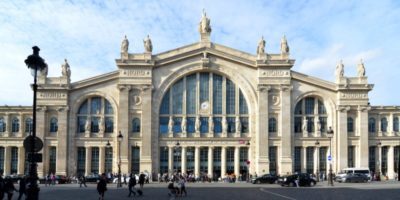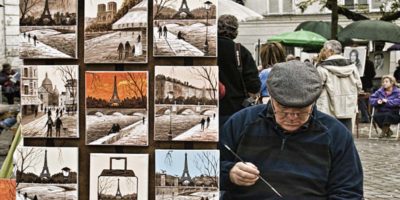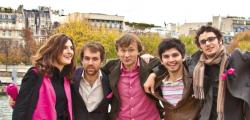
The Vienna Rathaus. Photo by Gryffindor. Wikimedia Commons
Top 10 Outstanding Facts about Rathaus
Rathaus which is the name of the City Hall of Vienna City in Austria is located in Rathausplatz in the Innere Stadt district and is the seat of the local and provincial government of Vienna.
Rathaus’ architectural designs and plans were drawn by Friedrich von Schmidt.
The Rathaus was constructed as from 1872 to 1883 mainly in Neo-Gothic style according to the plans of the architect.
The building houses the Vienna Landtag diet and the office of the Mayor of Vienna as well as the chambers of the city council.
The Rathaus was the world’s tallest building for a short period between 1892 to 1894, until it was overtaken by Milwaukee City Hall.
The top 10 outstanding facts about Rathaus include the following.
1. Rathaus Was Designed to Replace the Old Town Hall Which Became Too Small

Frederick III the Fair. Photo by Anton Boys. Wikimedia Commons
The offices in the old Vienna town hall were dedicated by Austrian duke Frederick the Fair in 1316.
The offices which became too small as time went by, were rebuilt by the Baroque architect Johann Bernhard Fischer von Erlach around 1700.
A competition to build a new city hall was initiated by city authorities to replace the old town hall which became too small.
The competition was won by the German architect Friedrich Schmidt who prepared the designs and plans for the new city hall i.e. the Rathaus.
To read more about Vienna follow this link
2. The Construction Cost of The Rathaus Amounted to About 14 Million Florins

Austrian Parliament Building. Photo by Ank Kumar. Wikimedia Commons
The location of Rathaus was proposed by then Mayor Cajetan Felder.
Mayor Cajetan Felder urged for the location to be on the boulevard where other representative buildings were erected such as the Vienna State Opera and the Austrian Parliament Building.
The main building of Vienna University and the Burgtheater are the other buildings erected near the location of the Rathaus.
The Rathaus was financed after a long debate by both the City of Vienna and the Imperial Royal government.
The total cost of constructing the building amounted to a total of 14 million florins.
To read more about Austrian Parliament Building follow this link
3. The Design of The Rathaus Was Modelled Mainly in Neo-Gothic Architecture

Rathausmann Statue. Photo by GuentherZ. Wikimedia Commons
The design of the richly adorned Rathaus was modelled like the Brussels Town Hall that is Neo-Gothic architecture akin to Flemish and Brabant secular buildings.
The building has five towers with the central tower measuring 98 meters in height being the tallest.
The Rathausmann statue erected on 21 October 1882 was installed at the top and became one of the symbols of Vienna.
The structure which is arranged around seven inner-courtyards, more along Baroque lines spreads over an area of 19,592 m2 or 210,890 square feet.
The Rathaus architecture embraces elements from neo-Gothic styles and also architectural styles from Baroque as well as other period styles.
To read more on the subject follow this link
4. The Rathaus Is Decorated with Limestone Mainly from Leitha Mountains and Ashlar Masonry
The total built up area of the Rathaus is about 1,220,000 square feet which is spread over two basements with 2,987 rooms and over thirty floors.
Limestone mainly from Leitha Mountains, and ashlar masonry were used to decorate most of the bricks that were used to build the Rathaus.
5. The Rathaus Accommodates the Historic ‘Wiener Rathauskeller’ Restaurant

Rathaus, Vienna. Photo by Michal Osmenda from Brussels, Belgium. Wikimedia Commons
The historic ‘Wiener Rathauskeller’ restaurant is accommodated in the Rathaus.
The restaurant offers small traditional Viennese delicacies to grand gala buffets to people within Vienna and its environs.
The ‘Wiener Rathauskeller’ restaurant is a traditional restaurant consisting of several baroque halls with palatial, grand decor and furnishings which is quite amazing to visitors.
6. Vienna Rathaus is the seat of the provincial and city government Among Others
Vienna is both a city and a province and as such the Rathaus is the seat of the provincial as well as the city government.
Notable institutions such as the City Library are housed in the Rathaus as well as hundreds of officials.
Art installations are hosted in the long façade in the Rathaus. A charity project has been putting up modern art up in the Rathaus windows with appropriate lighting with sponsorship from large companies.
7. The Rathausplatz Square Hosts Important Events Throughout the Year
The Rathausplatz which is located in front of the Rathaus is perhaps of more importance to visitors that the Rathaus due to events that are hosted therein every year.
Various important events are hosted in the open area i.e. Rathausplatz throughout the year which is located in front of the Rathaus.
The Vienna Eistraum open-air ice-skating rink and the Vienna’s Christkindlmarkt are hosted at the Rathausplatz every year.
8. Schmidt Was Both A Decent and A Cunning Architect

Friedrich Schmidt. Photo by PictureObelix. Wikimedia Commons
The German architect Friedrich Schmidt, who constructed the Rathaus was a decent as well as a cunning architect.
In 1854 a tailor named János Libényi tried unsuccessfully to kill Emperor Franz Joseph I as he was sampling some fresh air with one of his adjutants.
Thousands of generous subjects donated money to build the Votivkirche, a church in an act of gratitude for Franz Joseph’s survival of the assassination attempt.
The Votivkirche located some 400 meters north of the Rathaus was completed in 1879 with its tallest towers reaching 99 meters.
It is alleged that the emperor issued a decree that no new secular building should exceed the height of the Votivkirche.
The architect Schmidt capped the Rathaus tower at around 98 meters to ensure the building does not contravene the emperor’s decree.
However, the architect constructed the statue on top, Rathausmann, which enabled him get around the emperor’s decree.
Without the statue of Rathausmann, the name given to the armored knight at the top of the Rathaus’s central tower, the tower would be 98 meters in height but it measures 103.3 meters with it.
Schmidt therefore ensured “his” Rathaus became Vienna’s second-tallest building after Stephansdom cathedral with that little trick.
To learn more about Vienna click this link
9. Statues Depicting Important Figures Can Be Seen Near The Rathaus

Joseph Von Sonnenfels. Photo by Viennpixelart. Wikimedia Commons
Statues depicting important figures from Austrian history can be seen near the Rathaus in the Rathausplatz and environs.
The statue of the Jewish writer Joseph von Sonnenfels is one the statues erected in Rathausplatz.
The next statue which has been erected is of the composer Christoph Willibald Gluck which stands on the Karlsplatz.
10. The Rathausmann’s Armor Was Inspired by The Kit Worn by Emperor Maximilian I
Rathausmann is the name of a monument in the form of an armored knight at the top of the Rathaus’s central tower in Vienna.
The Rathausmann is modelled is the renaissance style knight and is adorned with armor worn during those times.
The Rathausmann armor was modeled after the kit worn by Emperor Maximilian 1 and it is one of Vienna’s symbols. The statue itself including a flagpole stands at 5.4 meters tall.
Planning a trip to Paris ? Get ready !
These are Amazon’s best-selling travel products that you may need for coming to Paris.
Bookstore
- The best travel book : Rick Steves – Paris 2023 – Learn more here
- Fodor’s Paris 2024 – Learn more here
Travel Gear
- Venture Pal Lightweight Backpack – Learn more here
- Samsonite Winfield 2 28″ Luggage – Learn more here
- Swig Savvy’s Stainless Steel Insulated Water Bottle – Learn more here
Check Amazon’s best-seller list for the most popular travel accessories. We sometimes read this list just to find out what new travel products people are buying.










